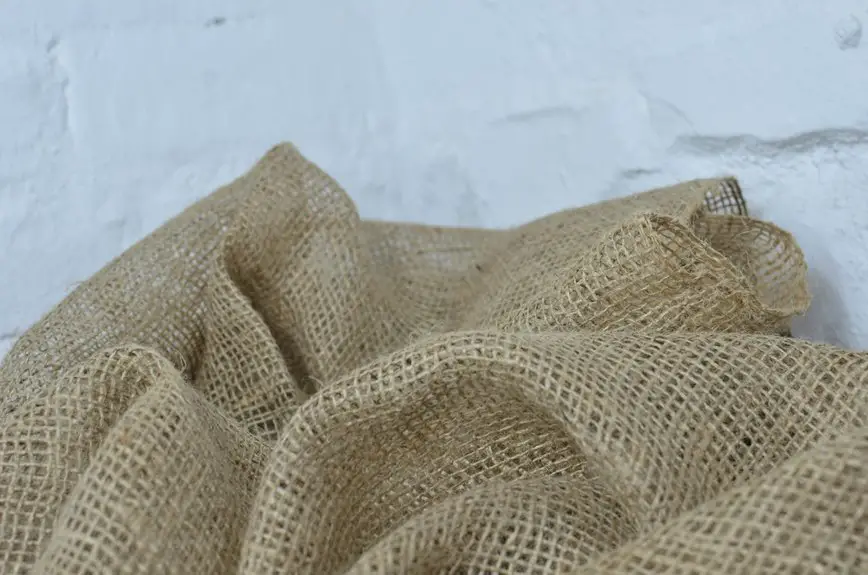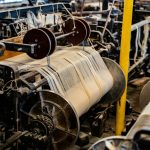You’ll find that jute fabric is made from the fibers of the Corchorus plant, mainly Corchorus olitorius and Corchorus capsularis, grown in warm, humid regions. After harvesting, the stalks undergo retting—a natural soaking process—to free the fibers. Jute is strong, biodegradable, and requires minimal water and chemicals compared to other crops, making it a smart, sustainable choice. If you’re curious about its unique qualities and eco-friendly benefits, there’s much more to discover.
Table of Contents
Key Takeaways
- Jute fabric is made from fibers of the Corchorus plants, mainly Corchorus olitorius and Corchorus capsularis.
- The fibers are extracted through retting, where stalks are soaked in water for 10 to 30 days to loosen fibers.
- Jute is a natural, renewable, and biodegradable fiber harvested from plants grown in warm, humid regions like Bangladesh and India.
- The fabric is often blended with organic cotton or recycled fibers to improve durability and versatility.
- Jute cultivation requires minimal pesticides and water, making it an eco-friendly and sustainable textile choice.
The Botanical Origin of Jute
Jute comes from the stems of plants in the Corchorus genus, primarily Corchorus olitorius and Corchorus capsularis.
When you look at these tall, leafy plants growing mostly in warm, humid regions like Bangladesh and India, you’re seeing the source of a versatile natural fiber.
As the plants mature, their stems develop long, soft fibers beneath the outer bark. You harvest the plants by cutting them close to the ground once they reach full growth.
Then, you subject the stems to retting—a soaking process that loosens the fibers from the woody core. After retting, you can separate and clean the fibers, preparing them for spinning into yarn.
Understanding this botanical origin helps you appreciate jute as a renewable resource rooted in nature’s design.
Characteristics of Jute Fibers
You’ll notice jute fibers have impressive strength and a distinct coarse texture that sets them apart.
They’re also biodegradable, making them an eco-friendly choice you can feel good about.
Plus, their breathability keeps things fresh, which is great for various fabric uses.
Fiber Strength and Texture
One key factor that makes this fabric popular is its impressive fiber strength combined with a coarse yet flexible texture.
When you handle jute, you’ll notice its fibers are tough, giving the fabric excellent durability for everyday use. This strength means jute resists wear and tear, making it ideal for items like bags, rugs, and upholstery.
At the same time, the texture isn’t stiff or brittle; instead, it has a natural roughness paired with enough pliability to shape and mold easily.
You can appreciate how this balance allows jute to be both sturdy and adaptable, providing a rustic appeal without sacrificing functionality.
Understanding these properties helps you see why jute remains a favored choice in sustainable textiles.
Biodegradability and Breathability
Beyond its strength and texture, this fabric also offers impressive environmental benefits through its natural biodegradability and breathability.
When you choose jute, you’re opting for a material that breaks down quickly and harmlessly in the environment, unlike synthetic fabrics that linger for decades. This means less waste piling up in landfills.
Plus, jute’s breathable nature helps regulate temperature and moisture, keeping you comfortable whether it’s hot or humid. Its open weave allows air to flow freely, reducing sweat and preventing odors.
The Process of Harvesting Jute
Although jute plants thrive in warm, humid climates, harvesting them requires careful timing to confirm the fibers remain strong and lustrous.
You’ll want to cut the plants just before they fully mature, usually after four to six months of growth. When you cut the stalks near the base, handle them gently to avoid damaging the fibers.
After harvesting, you’ll bundle the stalks together and transport them to a processing area. At this stage, it’s important to work quickly since prolonged exposure to sunlight can weaken the fibers.
Traditional Methods of Jute Retting
When you harvest jute stalks, the next essential step is retting, a traditional process that loosens the fibers from the woody core.
Retting is the crucial next step after harvesting, loosening fibers from the jute stalks’ woody core.
You typically submerge the stalks in slow-moving water, like ponds or rivers, for about 10 to 30 days, depending on the climate and water temperature. During this time, natural bacteria break down the pectin binding the fibers.
You need to monitor the retting closely to prevent over-retting, which weakens the fibers. After retting, the stalks become soft enough to separate the usable fibers from the woody parts easily.
This age-old method relies on natural elements and has been practiced for centuries, helping you produce strong, flexible fibers without chemicals—making it both eco-friendly and sustainable.
Extraction and Preparation of Jute Fibers
After retting, you’ll start extracting the jute fibers by gently stripping them from the softened stalks. This process, called stripping, separates the long, golden fibers from the woody core. You’ll carefully pull the fibers downwards, guaranteeing they remain intact and free from damage.
Once extracted, you’ll wash the fibers thoroughly to remove any remaining impurities and dried plant matter.
Next, you’ll dry the fibers under the sun, which enhances their strength and flexibility. After drying, the fibers are often sorted by length and quality.
Finally, you’ll bundle and compress them into bales, ready for spinning into yarn. This preparation guarantees the fibers are clean and uniform, making them ideal for producing durable, sustainable jute fabric.
Environmental Benefits of Jute Cultivation
Because jute cultivation requires minimal pesticides and fertilizers, it stands out as an eco-friendly crop you can rely on.
When you choose jute, you’re supporting a plant that naturally enriches the soil, reduces greenhouse gases, and conserves water. Its cultivation locks in carbon dioxide, helping combat climate change.
Here’s why jute benefits the environment:
- Soil Health: Jute improves soil fertility by adding organic matter, so you don’t have to worry about harmful chemicals degrading the land.
- Low Water Use: It needs far less water than cotton, so you contribute to water conservation when you pick jute.
- Carbon Sequestration: Jute plants absorb significant CO2, meaning you actively help reduce your carbon footprint.
Common Uses of Jute Fabric
Choosing jute not only supports the environment but also gives you access to a versatile fabric with many practical uses.
You can find jute in items like eco-friendly shopping bags, rugs, and curtains, which combine durability with a natural look. It’s perfect for home décor, adding texture without harming the planet.
Jute also works well in packaging materials, especially for agricultural products, thanks to its strength and breathability.
Ideal for packaging, jute offers strength and breathability, making it perfect for agricultural products.
If you’re into crafts or DIY projects, jute twine and ropes offer a sturdy, biodegradable option.
Additionally, jute blends with other fibers in upholstery and fashion, giving you sustainable choices without sacrificing style.
Comparing Jute to Other Natural Fibers
Natural fibers each bring unique qualities to the table, and jute stands out for its combination of strength, affordability, and eco-friendliness.
When you compare jute to other natural fibers like cotton, hemp, or flax, you’ll see distinct benefits that might surprise you.
- Jute is more sustainable than cotton because it requires less water and pesticides, making it a greener choice for your wardrobe or home.
- It’s stronger than hemp regarding tensile strength, so it holds up well under heavy use.
- Jute’s coarse texture gives it a rustic charm that’s perfect for décor, unlike the softer feel of flax.
Choosing jute means you’re supporting an eco-conscious fabric that doesn’t compromise on durability or style.
Innovations in Sustainable Jute Textile Production
While jute has long been valued for its eco-friendliness, recent innovations have taken sustainable jute textile production to new heights.
You’ll find that modern techniques reduce water and chemical use during processing, making the entire production cycle greener. Advances in bio-scouring and enzymatic treatments help you avoid harsh chemicals, preserving the fiber’s natural strength and softness.
You can also explore blending jute with organic cotton or recycled fibers to enhance durability and versatility without compromising sustainability.
Plus, digital printing and natural dyeing methods offer vibrant patterns while minimizing environmental impact.
These innovations mean you don’t have to sacrifice quality or style when choosing eco-friendly jute textiles.
Frequently Asked Questions
How Do You Wash and Care for Jute Fabric Products?
Think of jute like a gentle giant—handle it with care. You’ll want to spot clean with mild soap and cold water, avoid soaking, and air dry away from direct sunlight to keep it strong and beautiful.
Can Jute Fabric Cause Allergies or Skin Irritation?
Yes, jute fabric can cause allergies or skin irritation, especially if you have sensitive skin. You’ll want to test it first or avoid direct prolonged contact to prevent any discomfort or allergic reactions.
Is Jute Fabric Biodegradable and Compostable?
Think of jute fabric as Mother Nature’s gift—it’s completely biodegradable and compostable. When you toss it into your compost pile, it breaks down naturally, leaving no harmful residues behind, helping you reduce waste effortlessly.
What Colors and Patterns Are Available in Jute Textiles?
You’ll find jute textiles mostly in natural earthy tones like beige, brown, and green. However, manufacturers often dye or print vibrant colors and patterns, so you can get everything from stripes to florals for varied uses.
How Durable Is Jute Fabric Compared to Synthetic Fibers?
You’ll find jute fabric less durable than most synthetic fibers, as it’s more prone to wear and moisture damage. However, it’s strong enough for many uses and offers eco-friendly benefits synthetic options lack.
- Where Are My Pillow Percale Sheets Made? An Investigation - July 14, 2025
- What Is Washed Percale? A Guide to a Softer, Lived-In Feel - July 14, 2025
- What Is the Thread Count on My Pillow Percale Sheets? - July 14, 2025







